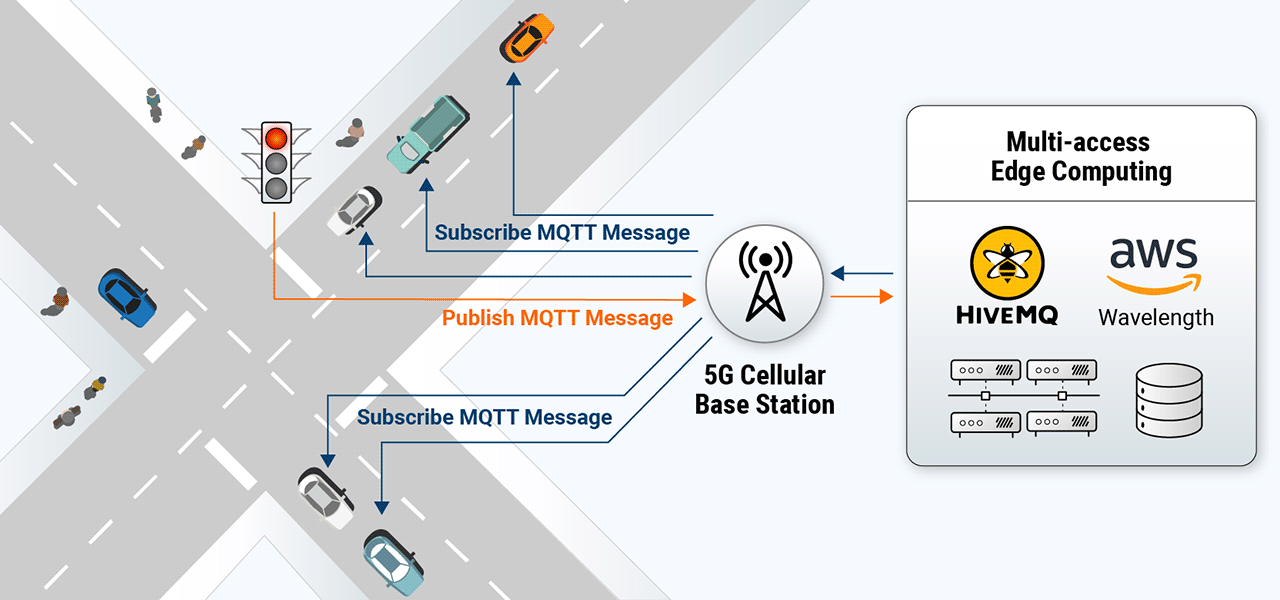Introduction to V2X
Multi-access edge computing and 5G networks are being rolled out around the world and will make possible an entire set of new use cases. In particular, for the automotive industry and road infrastructure the potential for real-time road and driving information will revolutionize road safety and traffic efficiency.
Vehicle-2-Everything (V2X) connectivity is about connecting vehicles (V2V), people (V2P) and infrastructure (V2I). New services might include pedestrian crosswalk warning signals that are transmitted to cars nearby, road work zone warning, stop sign gap analysis and traffic light signal optimization for traffic flow are all examples of the potential for V2X to reduce collisions with people and other vehicles and improve the overall efficiency of traffic management. The success of V2X will lead to reduced deaths and injuries due to automotive collisions and reduce the overall CO2 emissions created by automotive traffic.
The 5G infrastructure to enable V2X is being rolled out in major cities around the world. Carriers such as AT&T, Telekom, Verizon and Vodafone have 5G networks available today. Multi-access Edge Computing (MEC) data centers are being deployed to process the 5G network traffic as quickly as possible. AWS also has developed Wavelength to make it easy to run cloud native services in the MEC data centers. Verizon has deployed Wavelength in MEC across the USA and Vodafone is making Wavelength available in MECs across Europe (read our blog post: HiveMQ on AWS Wavelength at the edge of the 5G Network). The foundation for the future of V2X is being laid. The next steps are to enable the use cases and the applications.
A key challenge for V2X applications will be to transfer large amounts of data between the vehicles and the infrastructure. 5G networks will provide the network bandwidth to meet the low latency requirements. However, at the application level we need to consider the messaging technology to allow the different actors (vehicles and infrastructure) publishing and consuming data and to exchange the messages with very low latency. In this article, we will illustrate why MQTT is the ideal messaging protocol for V2X communication over 5G networks.
Technical Challenges of Implementing V2X Over 5G
There are a number of unique technical challenges when considering implementing a V2X service over a 5G network.
Real-time Low Latency of Data Movement
5G networks are designed to implement real-time applications. 5G network speeds can approach 20Gbps. For applications to take advantage of these 5G network speeds they need to minimize the application overhead of communicating between different clients (vehicles) and the infrastructure.
Large Amount of Data
A single vehicle is expected to generate approximately 10 messages per second. Creating an application infrastructure that can handle this amount of data and messages must be considered when designing an architecture.
Large Number of Vehicles
A V2X system needs to be able to support the interactions of tens of thousands of client connections, ex. vehicles and infrastructure on a network at the same time. These connections will be constantly entering and leaving a network, as they move through cities and the road infrastructure.
Limited Computing Resource Available in Multi-Access Edge Computing
The 5G MEC data centers will be powerful computing platforms that will run AWS Wavelength services like EC2 to support running higher level services. However, the computing infrastructure will not be unlimited like traditional cloud platforms offering elastic scalability to meet demand.
Fan-in / Fan-Out Communication
Many V2X use cases will involve a piece of infrastructure, f.e. a stop light, that will send a message that needs to be forward to many vehicles. This type of scenario is referred to as a fan-out message pattern that can be difficult to implement with traditional messaging technologies.
MQTT: A Messaging Solution for V2X
MQTT is a successful IoT messaging protocol that is well suited for V2X use cases. The automotive industry has embraced MQTT as the messaging standard for connected cars, so using MQTT for V2X services will be a natural extension.
MQTT is a publish/subscribe protocol that allows for a decoupled architecture of the clients from each other and the central broker. MQTT clients publish information on specific message topics and other MQTT clients subscribe to message topics they want to receive. The MQTT broker is the central broker that coordinates the publishing and subscribing of the MQTT clients.

The features of MQTT that make it well suited for connected car platforms are also very relevant for V2X use cases, including:
- The ability to have a persistent always-on connection between the broker and the vehicles, as they move around the network. If a vehicle loses a network connection, the session will continue to persist until the network is available. This significantly reduces the latency of requiring a vehicle to initiate a client connection to the application service.
- Support for the fan-out messaging pattern is inherited in the MQTT publish/subscribe message pattern. A stop light is able to publish on a specific topic that would be received by hundreds, if not thousands of vehicles in the area that subscribe to this topic when they are in the vicinity of the stop light.
- MQTT Quality of Service messages can guarantee delivery of a message at most once (QoS0), at least once (QoS1), and exactly once (QoS2). For safety critical use cases, guaranteed message delivery is something critical in the overall reliability of the implementation.
- MQTT 5 Shared Subscriptions are critical to be able to process and analyze the large number of messages that will flow through a V2X system. Shared subscriptions allow for the parallel processing of the MQTT messages to work on multiple messages of the same topic, while maintaining low latency.
- MQTT 5 Topic Alias is important to save bandwidth by replacing very long topic strings that include geo-location data with integers. For instance, an MQTT topic
country/city/geo-tile/service/vehicle-manufacturer/VIN/telemetrycould be replaced with a simple integer:1. This will reduce the message size by up to 35 bytes. If a car is sending 10 messages/second, this can result in significant savings for fleets of millions of cars. - MQTT 5 User Properties can be used to add meta information that would allow for interoperability between carriers and OEMs.
V2X Architecture with MQTT and HiveMQ

Major telcos that have deployed 5G networks are supporting application services by offering AWS Wavelength in the 5G data centers. AWS Wavelength allows a limited set of existing cloud native services to operate in the 5G data centers, including an MQTT broker like HiveMQ.
Once an MQTT broker service is available in a 5G network, V2X services can then be written to communicate with MQTT. Road infrastructure, like stop lights or stop signs, can be instrumented to publish information on an MQTT topic. Vehicles that move into proximity of the infrastructure, can subscribe to these topics to receive the information. Similarly, cars can publish information on topics that other cars who are local can subscribe to. The advantage of an MQTT based system is that all the MQTT clients are decoupled from each other so the system can organically grow and contract as the vehicles move around.
Implementing Low-latency V2X with HiveMQ
Low-latency at the application messaging level is paramount for a successful V2X service. HiveMQ has been working with industry partners as they prepare for V2X use cases for 5G rollouts. In some of these collaborations HiveMQ has demonstrated a message latency of 10ms round trip from the MQTT client publishing a MQTT message to HiveMQ MQTT broker running in a MEC to the subscribing MQTT client receiving the message.
Future of V2X and MQTT
V2X presents many exciting opportunities for innovative services for smart cities and connected vehicles. MQTT is a proven standard for connecting IoT devices and is well suited for V2X use cases. HiveMQ has been collaborating with major telecom carriers to develop proof of concepts using their 5G network infrastructure and MEC facilities with AWS Wavelength deployments. HiveMQ has demonstrated that MQTT and our HiveMQ MQTT broker meets the latency requirements for V2X use cases. The HiveMQ team also has the deep MQTT expertise required to architect large-scale V2X use cases. We welcome the opportunity to collaborate with other partners who are interested in deploying V2X services.
原文:How 5G and MQTT Accelerate Vehicle-2-Everything (V2X) Adoption (hivemq.com)

